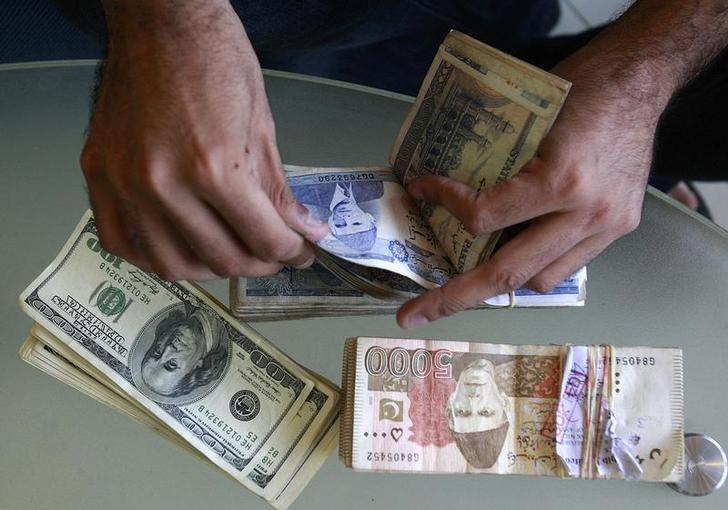
The issue warrants timely intervention by the authorities to avoid a rapid rise in inflation.
With an expected increase in petroleum prices, the latest weakness of the rupee would prove to be double jeopardy. The prime minister, who had earlier assumed the charge of finance ministry, faces a hard task to deal with key economic challenges including the twin deficits.
However, the good thing is that the government has finally made two decisions, appointing Miftah Ismail as the adviser and Rana Muhammad Afzal as the Minister of State for Finance. But how would both the gentlemen deal with serious issues like declining foreign currency reserves, rupee devaluation, inflation and external deficits is a million-dollar question.
More and more questions are being raised about the government’s inability to ensure exchange rate stability. There is a growing view that a gradual devaluation is needed to allow increase in exports.
Nobody is expecting that the Real Effective Exchange Rate should be abandoned. It is generally said that the speed with which devaluation is taking place, the rupee may soon reach Rs120-125 against the dollar and that some mechanism has to be urgently evolved with the support of other market players to have the much-needed exchange rate stability.
In fact, all this is happening in line with policies of the IMF that was urging the government to let the rupee fall 23% as the level was being artificially maintained, an advice often politely rejected by former finance minister Ishaq Dar. Those who are aware of the issue maintain that the rupee weakened to a record low when the State Bank of Pakistan (SBP) relaxed its grip on the managed-float currency, which is now further widening the current account deficit besides dealing a blow to the already reduced foreign exchange reserves.
The current account deficit has already widened 89% in first five months of FY18 compared to the corresponding period of 2016-17.
Earlier, the dollar had also slipped to Rs109, but was brought back to Rs104-105 by the finance minister, who then ordered an inquiry into what was said to be a big lapse.
But there is no denying the fact that during the previous devaluation the rupee weakened to Rs105 from Rs98. Later, reports revealed that it was some kind of connivance between central bank officials and those who manage the inter-bank rate to allow such a bigger devaluation that added Rs400 billion to the debt.
Total debt today stands at over Rs25.5 trillion that also includes $85 billion in external debt.
People buy more and more dollars
The prime minister took notice of the issue, saying that his government would not allow an unrealistic exchange rate. However, there was no follow-up and resultantly people prefer to hold and buy more and more dollars.
Who does not know that the dwindling of Pakistani currency is because of a sharp decline in reserves despite the fact the government borrowed $6 billion from commercial banks.
The irony is that there is double accounting of reserves both by the government and the commercial banks with independent economists calling it “accounting tricks” of the former finance minister who is still calling the shots by sitting in London.
In addition to borrowing $6 billion from the commercial banks, the government raised $2.5 billion in a dollar-denominated debt sale in Nov 2017.
Fears are being expressed that the rupee will fall to Rs114 ahead of general elections likely to be held in August 2018, though they were earlier planned for May. Exporters seem to be happy to see this devaluation to increase their exports. The important question, nonetheless, is whether the fresh devaluation has helped the currency to find its equilibrium.
Withheld assistance
One of the major reasons behind the devaluation is a sharp reduction in foreign inflows that made the reserves further vulnerable. The much-needed $300 million US Coalition Support Fund (CSF) was withheld by the Trump administration on the excuse that Pakistan was not helping to contain terrorism in the region.
The World Bank, IMF, ADB and other financial institutions are reluctant to offer increased assistance to Pakistan. Since America enjoys over 75% voting rights in Bretton Woods institutions (the World Bank and IMF), it is said to be using its influence to stop assisting Pakistan in any manner.
Now, when the pressure is building on foreign reserves, the government feels cornered to seek or not to seek another bailout package from the IMF.
Dar has been saying that the government did not need to go to IMF and the current level of reserves, which went close to $24 billion in 2016, but later declined to mere $9 billion excluding $5 billion of commercial banks, were sufficient to meet import and other pressing needs.
For the government, the situation became very embarrassing when State Bank Governor Tariq Bajwa conceded last week that Pakistan faced $12 billion of financing gap during the current financial year.
The bombshell, however, was dropped by the IMF when it said after the conclusion of post-programme monitoring talks that the country’s external sector would continue to remain under pressure. Was it not a double speak? IMF officials had been waiving conditions repeatedly during three years of the EFF programme and never held such a bleak view of the Pakistani economy.
It is being said that the IMF may not be that forthcoming this time around to offer any bailout package without attaching stringent conditions including the demand to drop sovereign guarantees for CPEC-related projects.
It would be done by the IMF on US persuasion which is opposing the Chinese-led One Belt, One Road initiative that also does not go down well with India. Going forward, further devaluation cannot be ruled out considering the weak reserves’ position, which needs to be bolstered through exports, increased FDI, improved home remittances and more importantly by deciding whether to seek a new IMF programme without which many believe the country cannot escape default.
The writer is the recipient of four national APNS Awards and four international best journalistic awards
Published in The Express Tribune, January 1st, 2018.
Like Business on Facebook, follow @TribuneBiz on Twitter to stay informed and join in the conversation.
1732603002-0/lamar-(4)1732603002-0-405x300.webp)
1720420084-0/brad-pitt-(2)1720420084-0-165x106.webp)















COMMENTS
Comments are moderated and generally will be posted if they are on-topic and not abusive.
For more information, please see our Comments FAQ